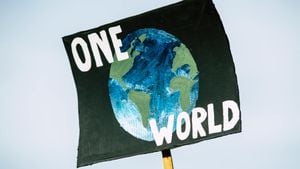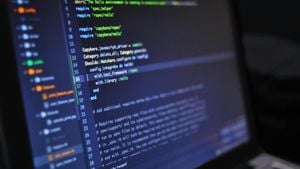Across the UK, tensions have boiled over as violent far-right riots made headlines, exhibiting alarming racial undertones and targeting immigrant communities. Following the tragic slaying of three young girls during a knife attack at a dance class, protests took to the streets, leading to disorder and mayhem. This incident acted as the trigger for what many are now calling the worst week of far-right unrest since World War II. Communities around the country found themselves caught up amid chaotic demonstrations turning violent, raising considerable fears about the safety of immigrants and asylum seekers.
This unprecedented wave of violence initially sparked following the heart-rending attack against children. Rioters targeted not only hotels housing asylum seekers but also attacked mosques. Images emerged of crowds pressing against hotel buildings, shouting slogans urging destruction. Activists employed social media to spread calls to action, inciting individuals across local areas to join the demonstrations. It is evident how contemporary technology allows for rapid mobilization; these protests were not centrally organized, fostering spontaneous anger and dread within communities.
Government officials quickly took notice of how rapidly the situation had escalated, expressing their concerns over safety. A series of threats emerged against various immigration law specialists, asylum support organizations, and charities, placing them firmly at the center of these protests. Social media posts included calls to action replete with disturbing imagery, heightening fears of increased violence against these groups.
Organizations like Tell Mama, which monitors forms of Islamophobia, have stepped up, alerting authorities and government agencies to the escalating threats. The question arises: how do we address this wave of violence? Activists from Stand Up to Racism organized counter-protests, urging communities to unite and demonstrate solidarity against racism. They emphasized the importance of voicing dissent against those who wish to create panic surrounding immigration, imploring, “They’ll realize they’re facing the whole of the community and they’re not speaking on our behalf.”
The situation garnered attention from political leaders like Prime Minister Keir Starmer, who condemned the riots and pledged to ramp up criminal justice efforts to hold offenders accountable—an announcement made post-emergency meetings with police chiefs. Starmer expressed support for law enforcement initiatives to crack down on rioting and spokespeople for the Prime Minister asserted there is “no justification for the chaos we have seen on our streets.”
Yet, the response to this violence raises concerns about potential discrimination. Prominent far-right figures leveraged this unrest to propagate incendiary narratives. Former Home Secretary Priti Patel criticized these comparisons, stating there exists significant disparity between several protest types, particularly differentiates them from the protests seen around the Black Lives Matter movement. Patel described current events as clear instances of “thuggery, violence, racism” rather than structured political protest. “What we are witnessing now is completely different,” she said, calling for parliament to address these chaos outbreaks.”
The unrest has spotlighted the issue of misinformation circulating on social media. A notable player, Elon Musk, found himself at the center of controversy after his comments on the matter—he suggested the UK was heading toward “inevitable civil war,” drawing sharp ire from government officials who described his sentiments as “no justification” for the violence. There’s been increased scrutiny over social media platforms handling the discourse surrounding these riots. Government officials have called on social media companies to be more proactive against the spread of dangerous content, recognizing their power to moderate the exchange of ideas.
These riots have exposed the growing disconnect between certain segments of society and the influences driving radical views. With notable figures from the previously mentioned far-right groups thriving among digital spheres, they have tapped local sentiments and grievances, capitalizing on momentous social issues. It’s through shared slogans—“enough is enough,” “stop the boats,” “save our children”—their messaging has permeated densely knit circles, galvanizing support. For many, it appears these demonstrations reflect more extensive social angst directed toward multiculturalism than any specific political agenda.
The disturbing reality reveals these rioters consist of diverse backgrounds yet united under the shared notion of racial resentment and dissatisfaction with societal changes. Political players routinely amplify divisive rhetoric, blurring the lines between criticism of immigration policy and outright racism. Such sentiments aren’t merely restricted to fringe groups, they are echoed, albeit subtly, across mainstream political discourse, driving people to adopt extreme views.
Following this chaotic outbreak, authorities are preparing for the long road toward resolving the situation, with the government planning to add 500 new prison places to accommodate those arrested during the rioting. Intended to advance public safety measures, these additional detentions are indicative of the government facing pressure to manage civil unrest effectively. The Lord Chancellor expressed the government’s commitment to strictly enforcing the law during these dire times, stating, “Those participating can expect to face the full force of our justice system.”
Alongside immediate actions taken, local communities must grapple with the notion of how to address the long-standing issues of racial divisions and prevent such situations from lingering. Critics argue this unrest is symptomatic of broader societal injustices begging for resolution. A ripple effect has ensued, with questions raised about how the government intends to combat these growing sentiments of anger and rage against marginalized groups.
Further complicity arises as English Defense League figures, who are typically associated with more organized nationalism, have engaged sporadically with these movements—only activating elements of broader dissent online. This inherent chaos underscores the decentralized nature of the contemporary far-right extremist scene. It’s no longer about structured groups facing off against the state; it represents various factions of society fueled by common grievances united against specific targets without clear leadership or goals.
What this tragedy illustrates is not merely the persistence of extremist ideologies; it signals societal fractures deepening within the impact of digital discourse and populism. A burning desire for belonging or solidarity has sparked cries for action, as diverse segments of society flex their collective anger. Responses are multifaceted and now more than ever, tackling these systemic issues will require collaborative action from the government, civil organizations and communities.
The motivation underlying the recent riots—a response to social ills perceived to afflict the nation—prompts the question, how can society heal? A concerted effort must be made fostering inclusivity and acceptance within communities traditionally tied to misinformation and division, and addressing those narratives head-on to prevent resurgence of such violence going forward. Unity rather than division could be the key to steering communities away from such chaos, emphasizing the importance of solidarity, rather than scapegoated anger.
It’s clear the events of this past week cannot be swept under the rug; they are requiring immediate, focused attention. Community dialogue combined with effective government intervention could steer away from the ever-lurking potential for divisive violence. Judging by history, proactive measures inciting trust and collaboration among diverse groups may be fundamental to creating safer, more harmonious societies. Will the tragic events catalyze social change necessary for healing or will they merely highlight the fractures long simmering beneath the surface? Only time will tell whether the nation can rise from these ashes to embrace the complexity borne from multicultural narratives rather than confront it with bigotry and hostility.



